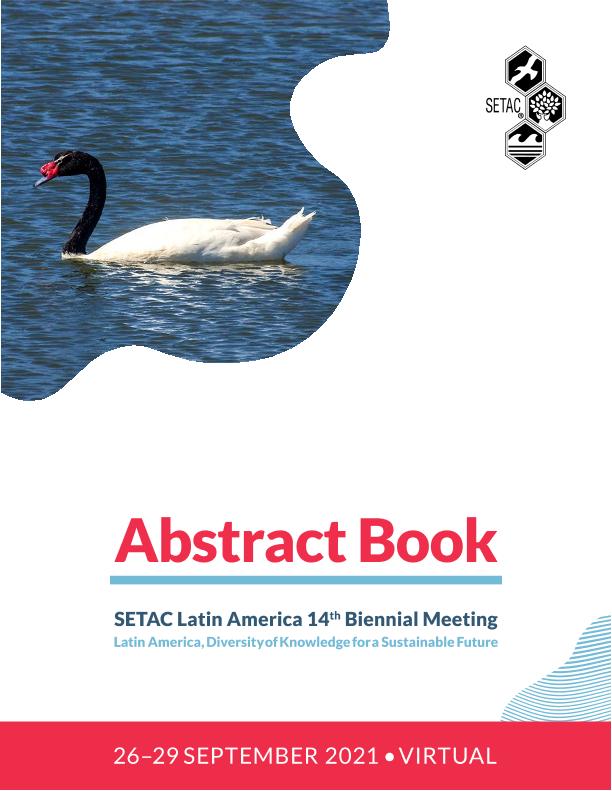Evento
Assessment of Erythrocyte Nuclear Abnormalities in Oiled Spheniscus Magellanicus As a Suitable Biomarker of Genotoxicity. New Tools for Rehabilitation Centers
Romero, María Belén ; Polizzi, Paula Sabrina
; Polizzi, Paula Sabrina ; Bauer, Julius; Dolagaratz Carricavur, Arantxa
; Bauer, Julius; Dolagaratz Carricavur, Arantxa ; Chiodi Boudet, Leila Natalia
; Chiodi Boudet, Leila Natalia ; Gerpe, Marcela Silvia
; Gerpe, Marcela Silvia
 ; Polizzi, Paula Sabrina
; Polizzi, Paula Sabrina ; Bauer, Julius; Dolagaratz Carricavur, Arantxa
; Bauer, Julius; Dolagaratz Carricavur, Arantxa ; Chiodi Boudet, Leila Natalia
; Chiodi Boudet, Leila Natalia ; Gerpe, Marcela Silvia
; Gerpe, Marcela Silvia
Tipo del evento:
Congreso
Nombre del evento:
SETAC Latin America 14th Biennial Meeting-
Fecha del evento:
26/09/2021
Institución Organizadora:
Society of Environmental Toxicology and Chemistry;
Título del Libro:
SETAC Latin America 14th Biennial Meeting
Editorial:
Society of Environmental Toxicology and Chemistry
Idioma:
Inglés
Clasificación temática:
Resumen
Genome stability is mainly influenced by individual genetic information and environmental factors and it can be used as index for an individual?s reaction on environmental impact and stress, such as pollutants. When birds are exposed to less than acutely lethal dosages, oil can cause a wide range of adverse effects, including hemolytic anemia, decreased nutrient absorption and decreased immune function. Evaluation of gene and cytotoxicity is an interesting field and valuable tool in environmental toxicology, although few studies have been conducted in wild birds. Among the methods for the estimation of genome instability is the evaluation of erythrocyte nuclear abnormalities (ENAs), which may be useful in field research of birds. The aim was to evaluate ENAs frequency in oiled Magellanic penguin (Spheniscus magellanicus) as biomarkers of genotoxicity. In addition, we assessed penguin recovery ability after rehabilitation process. Peripheral blood samples of oiled (n=29) and post-rehabilitation (n=21) Magellanic penguins were taken during 2011 and 2013 in Buenos Aires, Argentina. Blood smears were performed for analysis of ENAs, which included micronucleus, lobed nucleus, tailed nucleus, two-lobed nucleus, budding nucleus, nucleus with cavity, kidney-shaped nucleus and unknown nuclear malformation. Considering the total of ENAs, oiled penguins presented significantly higher levels than post-rehabilitation animals. In particular, oiled penguins presented higher values of the following ENAs: tailed nucleus, budding nucleus, kidney-shaped nucleus, nucleus with cavity and unknown nuclear malformation. No significant differences were found between groups for micronucleus and lobed nucleus. The present study represents the first approach on assessing not only the frequency of MN but also other ENAs in S. magellanicus. The micronucleus is the most widely used genotoxicity marker in birds. However, micronuclei was found in low frequency in all Magellanic penguins, indicating that the evaluation of other ENAs is a better biomarker to evaluate genotoxicity in the species. The results show that chronic oiling produces genotoxicity in Magellanic penguin, and that the rehabilitation process is adequate to reverse this damage. However, although the number of ENAs decreases in post-rehabilitation penguins, it is not known what the long-term damage is. Therefore it is important to record the effects of stressors such as oil for long-term comparisons.
Palabras clave:
STRESS RESPONSE
,
BIOMARKERS
Archivos asociados
Licencia
Identificadores
Colecciones
Eventos(IIMYC)
Eventos de INSTITUTO DE INVESTIGACIONES MARINAS Y COSTERAS
Eventos de INSTITUTO DE INVESTIGACIONES MARINAS Y COSTERAS
Citación
Assessment of Erythrocyte Nuclear Abnormalities in Oiled Spheniscus Magellanicus As a Suitable Biomarker of Genotoxicity. New Tools for Rehabilitation Centers; SETAC Latin America 14th Biennial Meeting-; Valdivia; Chile; 2021; 67-67
Compartir



